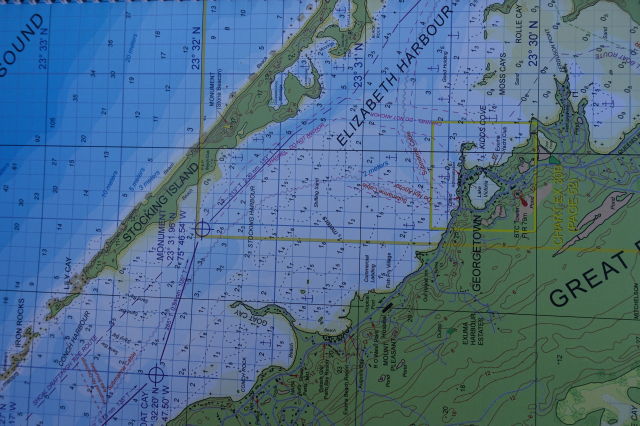
Our anchoring technique has been consistent for some time with minimal if any dragging so I thought we could share the process. In general, we usually anchor in locations we have never visited so the steps begin before arrival.
- Research the most updated cruising guide for suggested waypoints into the anchorage and enter them into the chart plotter or Multi-function display (MFD)
- Study the anchoring area on the MFD with recent sonarchart datatum. Create a path for your boat’s draft to the desired anchoring spot and an alternate spot, then drop some waypoints in the MFD. Find a spot more protected from waves than the wind.
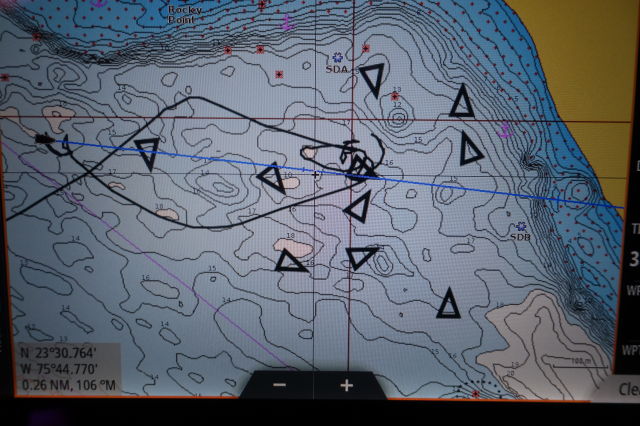
- Study the tide tables to time arrival with the incoming tide if possible. This allows you some options to clear yourself more quickly from potential grounding situations. The tide information will also give you an idea of any current you may encounter, especially if it is stronger than the prevailing wind.
- Amy goes to the bow as we enter the anchorage. We wear Sena Bluetooth headsets (aka marriage savers) to communicate. The combination of 50 feet of distance with a hard dodger in the way makes the traditional hand signal method difficult. Additionally, Amy can tell me what she is seeing on the bottom and the operating status of the windlass.
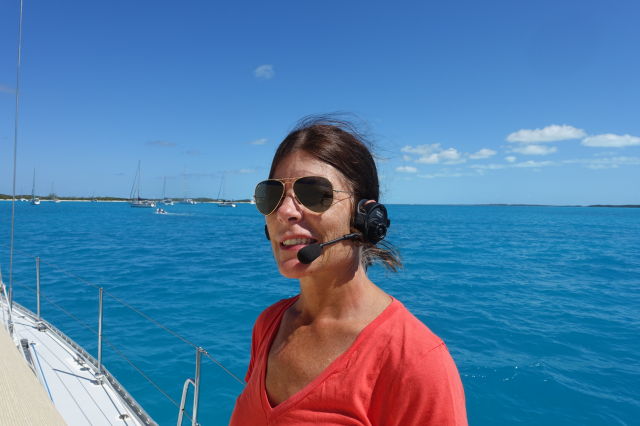
- After approaching the final waypoints I am done with the MFD. We have a depth display on the helm that is monitored closely but at this point feedback from Amy, visual observation of the bottom, nearby boats, wind and current are the priority. As they say in racing, get your head out of the boat and watch what is going on around you.

- Amy will use the windlass to release the chain lock.
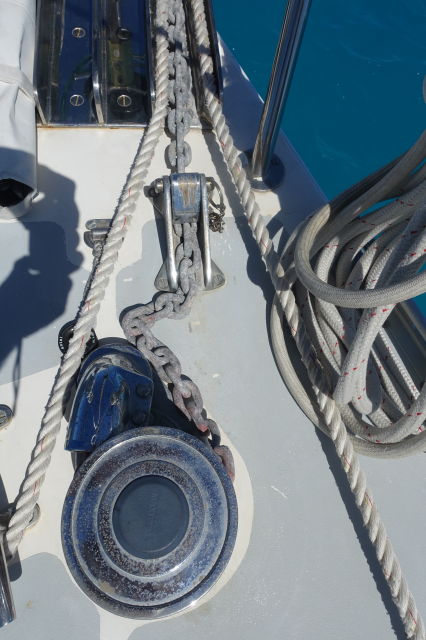
- Once we have a spot selected Amy will communicate if the bottom looks suitable (no rocks and minimal grass) as I head the boat into the wind or current. Outside of the tropics or in deep harbors we cannot see the bottom, so this step is skipped.
- I will put the engine in reverse until forward motion stops, then go into neutral as the wind brings us backwards. At this point I ask Amy to drop the anchor. We have windlass controls both forward and at the helm. We use the forward set of controls so Amy can stop the chain if we encounter any problems.
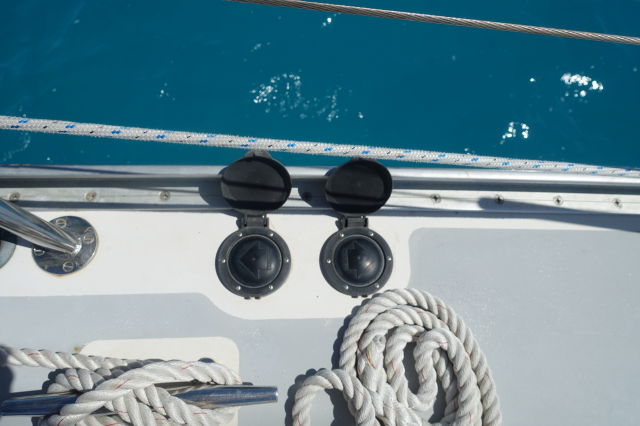
- We can monitor our rode length at release with both 25 foot length red paint chain markings and a chain counter instrument at the helm. Amy will alert with “first red”, “second red”, etc.
- Depending on the wind, depth, and bottom, we will let chain out to 5:1 and apply the chain lock. This is the ratio of length to depth. 5:1 would equate to around 50 feet of chain if the depth is 10 feet. If it is windy the boat will go sideways to the wind as the chain is deployed. We have found this shorter initial rode will force the anchor to set by itself without much assist in reversing the engine. A good sign it has set is if we go from sideways to the wind to pointing into the wind.
- If there is little wind or current, I will go into reverse lightly (start at idle and work slowly up to 1000 RPM) to set the anchor. A shaking chain is the best sign it has not set.
- Once we are comfortable the anchor has set, we will release chain to 6:1 scope or more depending on the conditions and distance of nearby boats and apply the chain lock. Amy will then return to the cockpit and I will turn off the engine.
- I will then take bearings on fixed positions on land and monitor the MFD to confirm we are not dragging. In the Bahamas I can also reference fixed objects on the sea floor!
- Once assured we are not dragging, I will attach the snubber, release a loop of chain, and re-apply the chain lock.
We are self-taught in this area, so I do not wish to override how sailing school instructors teach it. From watching other boats, it appears the majority let out the full rode and back much harder in reverse to set the anchor. My experience is you cannot get a “feel” of the bottom with the full length of chain out. I have also seen several boats use a combination of reverse engine and the bowthruster in setting the hook. I believe these boats are worried their chain will get tangled on itself, the keel, or running gear if they do not keep the bow straight. It seems logical that a slow motion set verifies the bottom conditions are conducive for the anchor to reset itself if the wind reverses which is valuable information. Of course this is all speculative and our good run could be based on our Spade anchor or the research of our desired anchor spot. Who knows, sailors will debate things like anchor designs and multihull vs monohull benefits into circular arguments that can make you crazy. In a lifestyle of everchanging locations and weather you need to stick with some things that work for you.

4 comments
Do you ever have a problem with the chain wrapping around the keel in areas with strong tidal currents? I used rope rode and after the third time that happened, I went to using two spaced out anchors,(Bahama style)
We have never had that problem with the anchor fortunately. We have wrapped the keel on a mooring at least two times I recall.
I really like that you don’t use the engine. Boats must has anchored this way for hundreds of years so surely it is tried and true! I suppose with a big boat you don’t need a lot of breeze to get a pretty strong pull to get it to set? We have very limited anchoring experience and this is one of the key things that worries me so thanks for sharing your technique! I was really stressed anchoring in Anagada in perhaps 20 knots but the flotilla captain who led us in told me to chill…”don’t worry mon, it will hold”…phew…
The Bahamas are just like Anegada, shallow and all sand so anchoring is a breeze. I believe heavy displacement boats do not move as much with moderate wind so a more powerful power nudge of inertia is needed. Renegade is relatively light to other boats her size so we get away with minimal reverse. I also believe anchors are designed to set at a slow velocity because boats that reverse at high speed seem to drag more before the grab.
Comments are closed.